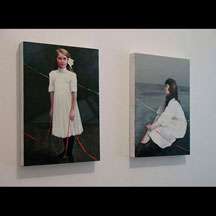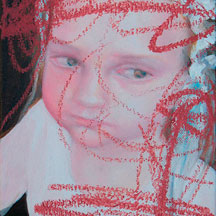Threads to the past
a series of paintings by Sarah Ettlinger
Critique by John Bicknell
The pictures are beautifully realized images in paint, using a delicate technique that brings to mind the strange combination of French eighteenth century portraiture – Ingre in particular and the melancholic light of Edward Hopper.
Light is crucial, not as illuminating external refraction, but as internal revelation, that is – the revelation of internal feelings – as if released from within. The progress of painting towards the modern hinges on the idea of light within – as in, for example, Corbet and Chardin. – Through to Rothko.
Light as the revelation of inner meaning – spirit even.
Yet, there is also the relationship with the chemical progeny of photography – and here the connection with mid period Richter becomes pertinent. The Kodak ‘family snap’ produces an exaggerated colour value, and Polaroid produces a high flash light that all but eradicates details of expression.
These paintings, similar to Richter, seem to take that ‘flash- white- out’ quality of certain types of photography, and process it through detailed and delicate brushwork and pale palette, into a dreamlike scene in which figures are isolated, and yet revealing moments of tenderness and joy.
The result is a series of images that draw the figures back into another time. And it then becomes clear that time as well as light forms a central theme in the work. The figures, which are family members, are suspended in time – they each occupy a period in time, a personal epoch, and yet they are connected –related in the way they are realized in paint.
The series becomes, then, catharsis through homogeneity. The act of painting, its facture and progress expresses a relationship with the family – whoever is identified as family – adoptive or biological.
This naturally raises the issue of ‘nature’ and ‘nurture’, an important and often misunderstood notion. What matters is how the paintings locate the painter in her own history, and how that history resonates with all of us.
The paintings clearly form a series – one connecting to another- both historically and emotionally. We begin to see a family tree developing. Underlying the related images is the question and problem of identity, and of belonging.
 Lost Innocence
Lost Innocence
The paintings of Sarah Ettlinger
Critique by John Bicknell
The recent paintings of Sarah Ettlinger explore the complex relationship between child and parent through a series of images that concentrate on the subltle and often unnerving expressions and movements of the developing child.
Using photographs taken by the the artist of her children, Ettlinger shifts and changes the scale and perspective in her painting to create a world that both parrallels the sense of wonder and innocence of the child, and at the same time issues new possibilities in the way that we can make sense of the human image.
By using the emotive and vulnerable relationship between mother and child, Ettlinger places herself very personally at the heart of the subject. The painting is then not simply the recording and reporting of visual facts, but a mapping of the unpredictable ebb and flow of emotion.
The paintings focus on the face, reducing the body and limbs to a space behind the picture plane. This creates a dreamlike spacial quality, perhaps to evoke childrens dreams, or the psychological scale prioritisation in the mind of the developing child.
The images certainly oscilate in the imagination between innocence and provocation, even the implication of menace, much like the physical behaviour in young children, as they negociate the emotional terrain of life.
The paintings expose the contradictions and mysterious changes in childrens behaviour that challenge our own assumptions about ourselves as adults.
These visceral projections, delicately realised through the tradition of figurative oil painting, are then challenged by the free mark making across the surface, which are derived from drawings made by the children themselves.
The small tapestries are a sigificant development. Whilst adopting the same images of children, they transpose the swift instinctive abstract marks and shapes into the slow, painstaking process of the surface weave. A pertinent contradiction of image process and method, which serves to highlight the transitional nature of child development with a sense of permenence embued in the tradition of tapestry; which also references the historically female, as apposed to feminine, art of embroidery.
Throughout Ettlingers work there is a constant awareness of painted light.
This is revealed in the close observation of skin tones, and the behaviour of light across the surface of fabric. There is always a clarity of light, as in Vermeer or Ingre as historical antecedents, but also a pale contemporary realism, the product of the post Kodachrome digital age, through which the figures posseses an almost spectral hyper realism. Perhaps as high definition digital technology advances further into our lives, the interface between painting, photography and film becomes ever more compelling.
Ettlingers paintings probe and challenge this threshold.
John Bicknell January 2013